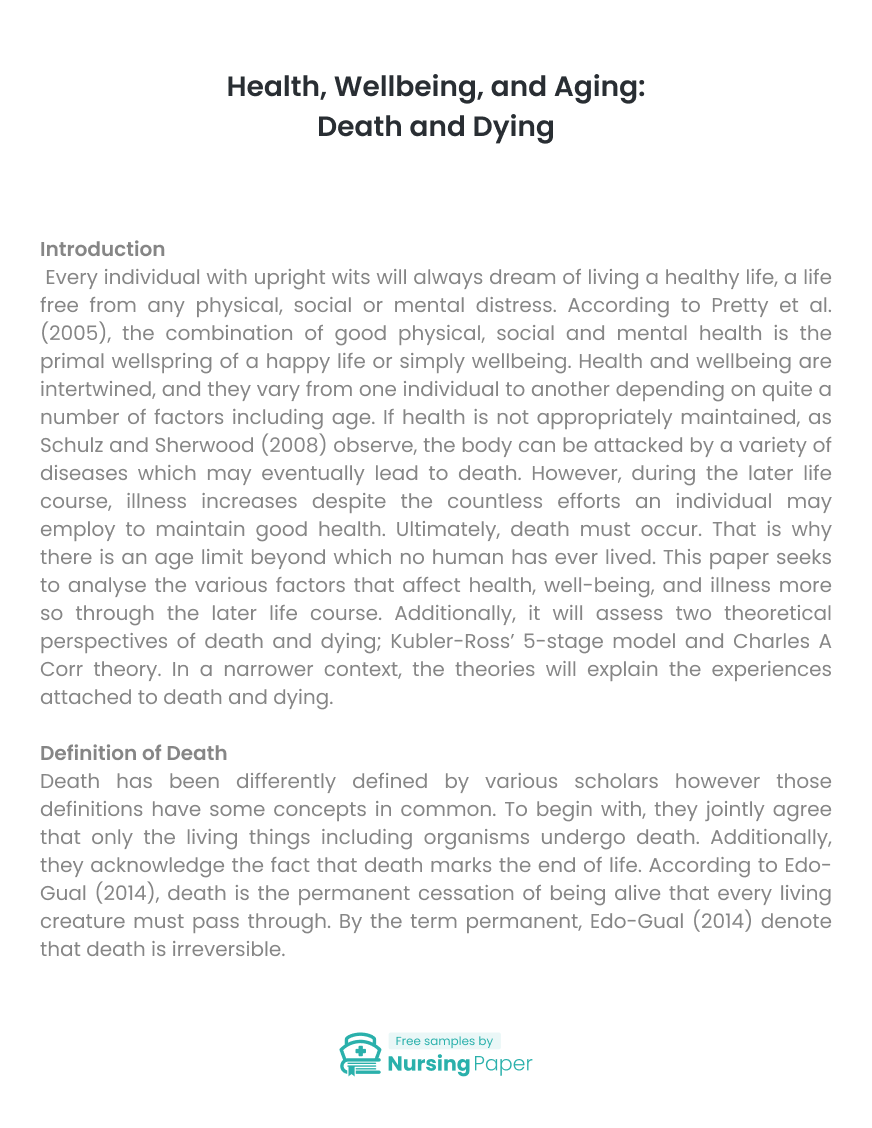1. Basmajian, C. and Coutts, C., 2010. Planning for the disposal of the dead. Journal of the American Planning Association, 76(3), pp.305-317.
2. Chapman, R., 2013. Death, burial, and social representation. In the Oxford Handbook of the Archaeology of Death and Burial, 22(13), pp.117-156.
3. Clark, J., 2003. Patient centred death: We need better, more innovative research on patients’ views on dying. BMJ: British Medical Journal, 327(7408), p.174.
4. Edo‐Gual, M., Tomás‐Sábado, J., Bardallo‐Porras, D. and Monforte‐Royo, C., 2014. The impact of death and dying on nursing students: an explanatory model. Journal of Clinical Nursing, 23(23-24), pp.3501-3512.
5. Fahlander, F. and Oestigaard, T. eds., 2008. The materiality of death: bodies, burials, beliefs (pp. 1-16). Oxford: Archaeopress.
6. Friedman, R. and James, J.W., 2008. The myth of the stages of dying, death and grief. Skeptic (Altadena, CA), 14(2), pp.37-42.
7. Gardiner, C., Gott, M., Small, N., Payne, S., Seamark, D., Barnes, S., Halpin, D. and Ruse, C., 2009. Living with advanced chronic obstructive pulmonary disease: patients concerns regarding death and dying. Palliative Medicine, 23(8), pp.691-697.
8. Green, J.W., 2012. Beyond the good death: The anthropology of modern dying. University of Pennsylvania Press.
9. Hall, C., 2011. Beyond Kubler-Ross: recent developments in our understanding of grief and bereavement. InPsych: The Bulletin of the Australian Psychological Society Ltd, 33(6), p.8.
10. Henry, A.G., Brooks, A.S., and Piperno, D.R., 2010. Microfossils in calculus demonstrate consumption of plants and cooked foods in Neanderthal diets (Shanidar III, Iraq; Spy I and II, Belgium). Proceedings of the National Academy of Sciences, p.201016868.
11. Irish, D.P., Lundquist, K.F. and Nelsen, V.J., 2014. Ethnic variations in dying, death and grief: Diversity in universality. Taylor & Francis.
12. Kaplan, B.J., 2009. Divided by faith: Religious conflict and the practice of toleration in early modern Europe. Harvard University Press.
13. Kasket, E., 2012. Continuing bonds in the age of social networking: Facebook as a modern-day medium. Bereavement Care, 31(2), pp.62-69.
14. Leming, M.R., and Dickinson, G.E., 2010. Understanding dying, death, and bereavement. Cengage Learning.
15. Lippolis, E. and Calio, L., 2016. Halicarnassus and the Mausoleum. The modern City Layout of the late Classic period and the grave Temple of the Carian King Mausolus celebrated as a wonder of the World, 13(1), pp.213-215
16. Pretty, J., Griffin, M., Peacock, J., Hine, R., Sellens, M. and South, N., 2005. A countryside for health and wellbeing: the physical and mental health benefits of green exercise–executive summary. Countryside Recreation Network.
17. Rebay-Salisbury, K., 2012. Inhumation and cremation: how burial practices are linked to beliefs. Embodied knowledge: Historical perspectives on technology and belief, pp.15- 26.
18. Richards, N., 2012. The right-to-die: older people and death activism. international Journal of Ageing and later life, 7(1), pp.7-32.
19. Rodin, G. and Zimmermann, C., 2008. Psychoanalytic reflections on mortality: a reconsideration. Journal of the American Academy of Psychoanalysis and Dynamic Psychiatry, 36(1), pp.181-196.
20. Rowbotham, J., and Clayton, P., 2008. An unsuitable and degraded diet? Part three: Victorian consumption patterns and their health benefits. Journal of the Royal Society of Medicine, 101(9), pp.454-462.
21. Schulz, R. and Sherwood, P.R., 2008. Physical and mental health effects of family caregiving. Journal of Social Work Education, 44(sup3), pp.105-113.
22. Semple, S., 2013. Perceptions of the Prehistoric in Anglo-Saxon England: Religion, ritual, and rulership in the landscape. Oxford University Press.
23. Sormanti, M. and Ballan, M.S., 2011. Strengthening grief support for children with developmental disabilities. School Psychology International, 32(2), pp.179-193.
24. Wasserman, L.S., 2008. Respectful death: A model for end-of-life care. Clinical Journal of Oncology Nursing, 12(4), p.621.
25. Watanabe-O’Kelly, H., 2017. Early modern European festivals—politics and performance, event and record. In Court Festivals of the European Renaissance (pp. 15-25). Routledge.

The download will start shortly.






 Subject:
Subject:
 Number of pages: 18
Number of pages: 18